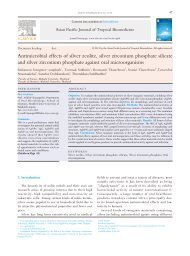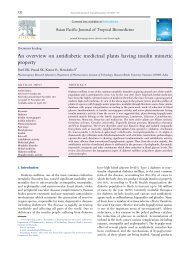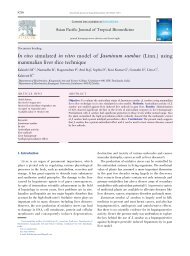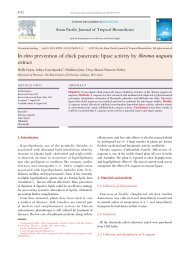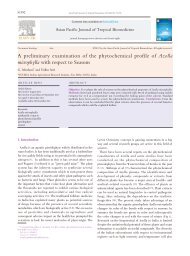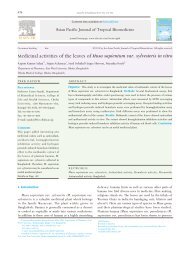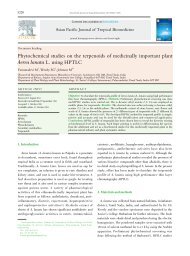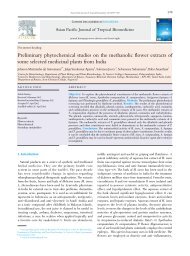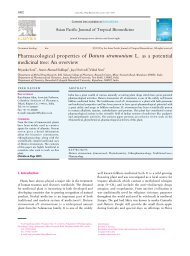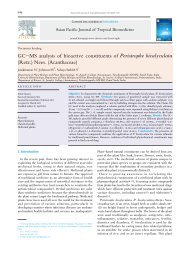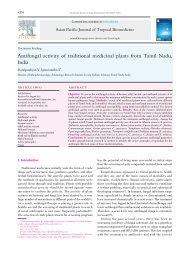Larvicidal and repellent potential of Moringa oleifera ... - Apjtb.com
Larvicidal and repellent potential of Moringa oleifera ... - Apjtb.com
Larvicidal and repellent potential of Moringa oleifera ... - Apjtb.com
Create successful ePaper yourself
Turn your PDF publications into a flip-book with our unique Google optimized e-Paper software.
<strong>and</strong> typically are free from harmful effects [6]. Because <strong>of</strong> this,<br />
much interest has been focused on plant extracts, or plant<br />
essential oils as <strong>potential</strong> mosquito <strong>repellent</strong> agents [7,8] <strong>and</strong><br />
studied the interactive effect <strong>of</strong> botanicals (Neem, Pongamia)<br />
<strong>and</strong> Leucas aspera, Bacillus sphaericus against the larvae <strong>of</strong><br />
Culex quinquefasciatus.<br />
<strong>Moringa</strong> <strong>oleifera</strong> (M. <strong>oleifera</strong>) is the most widely cultivated<br />
species <strong>of</strong> a monogeneric family-the <strong>Moringa</strong>ceae, native<br />
to the sub-Himalayan tracts <strong>of</strong> India. This rapidly-growing<br />
tree (also known as the horseradish tree, drumstick tree,<br />
benzolive tree, kelor, marango, mlonge, moonga, mulangay,<br />
nebeday, saijhan, sajna or Ben oil tree), was utilized by the<br />
ancient Romans, Greeks <strong>and</strong> Egyptians, <strong>and</strong> it is now widely<br />
cultivated <strong>and</strong> has be<strong>com</strong>e naturalized in many locations in<br />
the tropics. All parts <strong>of</strong> the <strong>Moringa</strong> tree are edible <strong>and</strong> have<br />
long been consumed by humans. In the West, one <strong>of</strong> the<br />
best known uses <strong>of</strong> <strong>Moringa</strong> is to flocculate contaminants<br />
<strong>and</strong> purify drinking water with its powdered seeds [9-11]. This<br />
tree has in recent times been advocated as an outst<strong>and</strong>ing<br />
indigenous source <strong>of</strong> highly digestible protein, Ca, Fe,<br />
Vitamin C, <strong>and</strong> carotenoids suitable for utilization in many<br />
<strong>of</strong> the so-called “developing” regions <strong>of</strong> the world where<br />
undernourishment is a major concern. In the present study<br />
an attempt was made to evaluate the toxicity <strong>of</strong> M. <strong>oleifera</strong><br />
on malarial vector, Anopheles stephensi (An. stephensi).<br />
2. Materials <strong>and</strong> methods<br />
2.1. Plant collection <strong>and</strong> preparation <strong>of</strong> plant extract<br />
The plant M. <strong>oleifera</strong> was collected from the area around<br />
Bharathiar University, Coimbatore. The dried plant materials<br />
were powdered by an electrical blender. From each sample,<br />
100 g <strong>of</strong> the plant materials were extracted with 300 mL <strong>of</strong><br />
methanol for 8 h in a Soxhlet apparatus. The plant extracts<br />
were evaporated to dryness in rotary vacuum evaporator to<br />
yield 122 mg <strong>and</strong> 110 mg <strong>of</strong> dark greenish material (residue)<br />
from Arcang amara <strong>and</strong> Ociumum basilicum, respectively.<br />
One gram <strong>of</strong> each plant residue was dissolved separately<br />
in 100 mL <strong>of</strong> acetone (stock solution) from which different<br />
concentrations, i.e., 20, 40, 60, 80 <strong>and</strong> 100 ppm were prepared.<br />
2.2. Test for larvicidal activity [12]<br />
An. stephensi was used to test the the larvicidal <strong>and</strong><br />
pupicidal activity <strong>of</strong> M. <strong>oleifera</strong>. It was maintained at (27暲<br />
2) 曟, (75%-85%) RH, under 14 L: 10D photoperiod cycles.<br />
The larvae were fed with dog biscuits <strong>and</strong> yeast at 3:1 ratio.<br />
Twenty-five I, II, III <strong>and</strong> IV instar larvae <strong>and</strong> pupae <strong>of</strong><br />
An. stephensi were kept in 500 mL glass beaker containing<br />
249 mL <strong>of</strong> dechlorinated water <strong>and</strong> 1.0 mL <strong>of</strong> desired<br />
plant extract concentration. Three replicates for each<br />
concentration were set up. A control was set up with 1.0 mL<br />
<strong>of</strong> acetone in 249 mL <strong>of</strong> dechlorinated water. The control<br />
K. Prabhu et al./Asian Pacific Journal <strong>of</strong> Tropical Biomedicine (2011)124-129 125<br />
mortality was corrected by Abbott's formula [13] <strong>and</strong> LC 50,<br />
LC 90, regression equation, <strong>and</strong> 95% confidence limit <strong>of</strong> lower<br />
confidence limit (LCL) <strong>and</strong> upper confidence limit (UCL)<br />
were calculated by using probit analysis [14].<br />
2.3. Pupicidal activity<br />
A laboratory colony <strong>of</strong> mosquito pupae was used for<br />
pupicidal activity. Ten freshly emerged pupae were<br />
introduced into each testing cup (sterilized plastic<br />
drinking cup <strong>of</strong> 150 mL capacity), which contained 100 mL<br />
<strong>of</strong> dechlorinated tap water. A measured volume <strong>of</strong> stock<br />
solution was added to obtain the desired concentrations.<br />
Experiments were carried out with a series <strong>of</strong> fiveseven<br />
concentrations, 20%, 40%, 60%, 80%, <strong>and</strong> 100%,<br />
respectively, each with 5 replicates <strong>and</strong> a final total number<br />
<strong>of</strong> 100 pupae for each concentration. The LC 50 <strong>and</strong> LC 90 were<br />
determined by a probit analysis program [14]. Control mortality<br />
was accounted by the formula <strong>of</strong> Abbott's [13].<br />
2.4. Repellent activity<br />
Repellent activity <strong>of</strong> plant <strong>com</strong>pounds was tested with<br />
human volunteers. For the <strong>repellent</strong> activity <strong>of</strong> plant extracts<br />
percentage protection in relation to dose method was<br />
adopted [7,12]. Three to four days old blood starved female<br />
adult mosquitoes (100) were kept in a net cage. The arms <strong>of</strong><br />
the tested person were cleaned with isopropanol. After airdrying<br />
the arm only 25 cm 2<br />
<strong>of</strong> the dorsal side <strong>of</strong> the skin on<br />
each arm was exposed, the remaining area being covered by<br />
rubber gloves.<br />
The plant extract was dissolved in isopropanol <strong>and</strong> the<br />
alcohol served as control. The plant extract at 0.5, 1.0 <strong>and</strong> 2.0<br />
mg/cm 2<br />
concentrations was applied. The control <strong>and</strong> treated<br />
arms were introduced simultaneously into the cage. The<br />
number <strong>of</strong> bites was counted over 5 min every 60 min, from<br />
20:00 to 6:00. The experiment was conducted five times. The<br />
percentage protection was calculated by using the following<br />
formula.<br />
Number <strong>of</strong> bites received by control arm -<br />
Number <strong>of</strong> bites received by treated arm<br />
% Protection = 暳 100<br />
Number <strong>of</strong> bites received by control arm<br />
T = the number <strong>of</strong> mosquitoes collected from treated areas.<br />
2.5. Smoke toxicity test<br />
M. olifera seed extract was used for smoke toxicity assay.<br />
The mosquito coils were prepared following the method <strong>of</strong><br />
Saini et al [15] with minor modification by using 4 g <strong>of</strong> coconut<br />
shell, charcoal powder as burning material. All the three was<br />
thoroughly mixed with distilled water to form a semisolid<br />
paste. Mosquito coils (0.6 cm thickness) were prepared<br />
manually <strong>and</strong> shade dried. The control coils were prepared<br />
without the plant ingredient.



